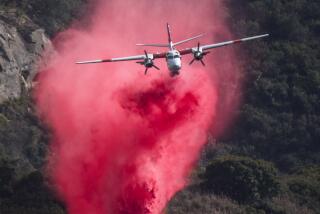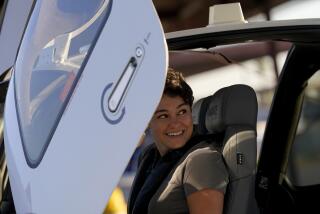Sky’s the Limit on Training Budget for Pilots With ‘Right Stuff’ : Aviation: Fliers today have better-designed aircraft to challenge them because supercomputers can simulate a greater variety of conditions.
- Share via
CRANFIELD, England — They’re not destined to be top guns, but they definitely have the right stuff and they cost a fortune to train.
They are the cream of aviators, learning to be test pilots at military and civilian schools in Britain, France and the United States.
Governments, airlines and aircraft manufacturers from South Korea and Singapore to Norway and Italy pay from $335,000 to $850,000 per pilot for a year of training.
“Test pilots are very expensive to train because they need a wide variety of experience on different types of aircraft,” said Mervyn Evans, chief instructor at the private International Test Pilots School in Cranfield.
“Typically, you’re talking about something like 5,000 to 10,000 pounds ($7,150 to $14,300) an hour in a military jet,” he said.
On a cold, windy day at Cranfield, Flight Lt. Robyn Williams, 32, of Sydney, Australia, was about to take off in a single-engine PC-6 as part of a training course that will include testing Czech aircraft this summer.
She is one of the Australian military’s first two female pilots and is to be its first woman test pilot, but she does not see herself as a pioneer.
“I’ve just done it because I wanted to do it,” she said. “The fact that I happen to be the first one in Australia that’s done it is more coincidental.”
Williams and two other trainee pilots, 1st Lt. Tore Reimers, 28, of the Norwegian air force and Capt. Ackbal Abdul Samad, 30, of the Malaysian air force, said they were excited by the challenge.
Clifford Beal, aerospace editor of Jane’s International Defense Review, said pilots have better-designed aircraft to test today because supercomputers can simulate many flight conditions.
It can be hazardous work, though.
The advanced American F-22 fighter crashed last year, and two of the U.S. Navy’s experimental tilt-rotor Osprey V-22s have crashed. In 1989, the Swedes crashed their new combat aircraft, the Gripen JAS 39.
“I think it’s a certain type of person who goes into being a test pilot--people who crave excitement and danger,” Beal said. “There’s still a certain amount of bravado.”
Without test pilots, manufacturers cannot get new aircraft certified. The right training can mean the difference between life and death to the pilot and prevent the loss of multimillion-dollar aircraft.
Perhaps the most famous test pilot was Chuck Yeager, who became the first to break the sound barrier and was the hero of the movie “The Right Stuff.”
For decades, the only pilots with “the right stuff” were male, but American women recently have cracked the elite world of test pilots: The Air Force and Navy have three each, while the British and French military still have none.
Western powers still dominate the training of test pilots and engineers. The four major schools, all military, are run by the U.S. Navy in Patuxent, Md., the U.S. Air Force at Edwards Air Force Base near Mojave, Calif., Britain at Boscombe Down and France at Istres.
India and China also have opened training establishments, said Evans, a graduate of the U.S. Navy school.
The high cost of military training and the needs of commercial customers led to the establishment of private schools such as the one opened in 1985 at Cranfield, 40 miles north of London.
“We train people to be very precise pilots,” said Sean Roberts, founder of the private National Test Pilot School in Mojave, Calif. “There’s no wild flying involved in it at all.”
Roberts started his school in 1981 because big U.S. aviation companies such as Boeing and McDonnell Douglas said they could not afford the military schools.
He charges $335,000 for the one-year course. By comparison, the British course costs about $700,000, the U.S. Navy’s $750,000 to $800,000 and the U.S. Air Force’s $850,000.
More to Read
Inside the business of entertainment
The Wide Shot brings you news, analysis and insights on everything from streaming wars to production — and what it all means for the future.
You may occasionally receive promotional content from the Los Angeles Times.










